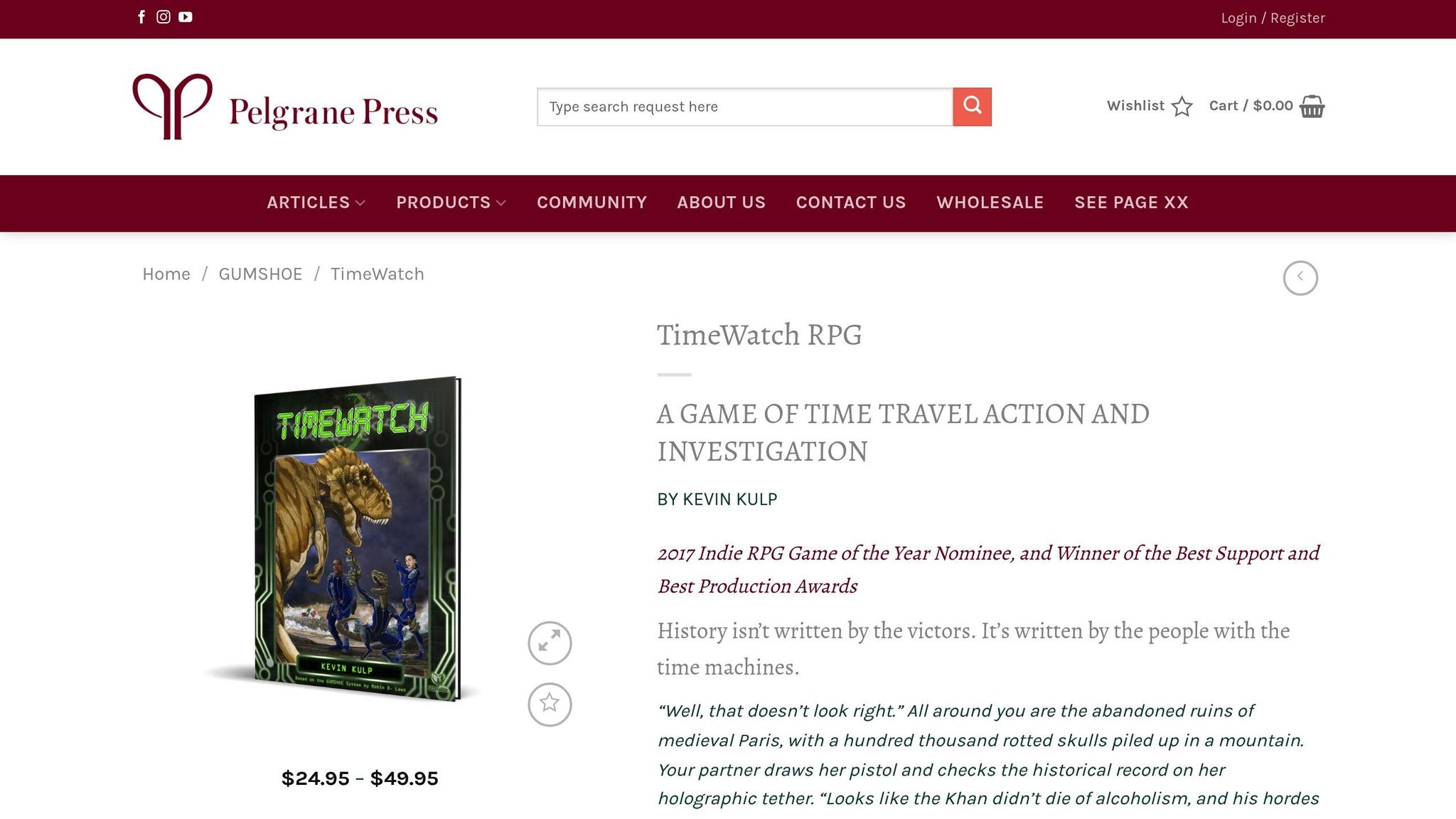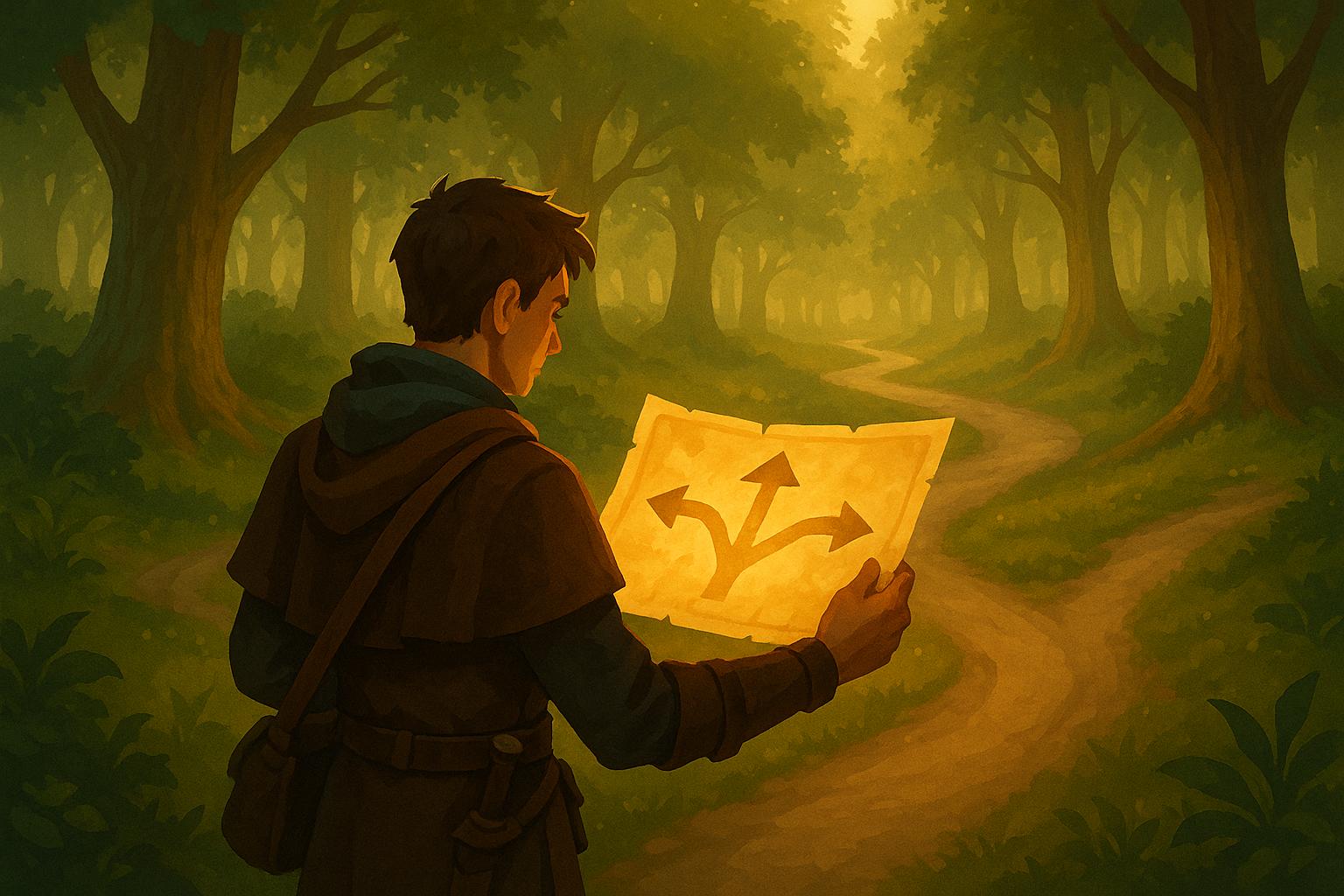Time travel RPGs thrive on blending historical detail with player-driven storytelling. The key is to create a believable world that respects historical contexts while allowing players to shape their own narratives. This guide breaks down how to balance accuracy, handle sensitive topics, and manage time travel mechanics.
Key Takeaways:
- Why Accuracy Matters: Historical details - like period-appropriate customs, technology, and events - enhance immersion and decision-making.
- Challenges: Managing timelines, avoiding paradoxes, and ensuring respectful portrayals of history are critical.
- Research Tips: Use primary sources, museum archives, and academic publications to ground your game in historical fact.
- Game Design Techniques: Incorporate historical events, figures, and settings naturally. Use alternate histories and timeline rules to expand possibilities.
- Player Engagement: Build the world collaboratively, use visual aids, and weave historical details into gameplay without overwhelming players.
Pro Tip: Tools like the TTRPG Games Directory can simplify research and provide pre-built frameworks for historical settings. The goal is to craft a game that respects history while letting players explore and make meaningful choices.
TimeWatch RPG explained

Research Methods for Historical Accuracy
Thorough research is the backbone of crafting believable historical time travel RPGs. While you don’t need a PhD in history, knowing how to dig into reliable sources and use that information effectively is key. The goal is to build a solid historical framework that enhances your game without overwhelming it.
Finding Reliable Historical Sources
To start, focus on academic books and peer-reviewed journals. Publications from university presses like Oxford, Cambridge, or Harvard are excellent resources, offering well-researched material to ground your game in historical fact.
Primary sources are invaluable for capturing the essence of a time period. Letters, diaries, government records, and contemporary newspapers provide a window into daily life. For instance, digitized archives from the Library of Congress can reveal personal stories and societal concerns during major historical events.
Museum websites and archives are another treasure trove of information. Institutions like the Smithsonian or the British Museum host online collections with photos, artifacts, and manuscripts, often accompanied by detailed explanations and historical context.
Documentary films and history-focused podcasts can help you grasp the bigger picture, but make sure to cross-check these insights with written records to avoid inaccuracies. Similarly, Wikipedia is a decent starting point for finding academic references, but it should never be your sole source. And while historical fiction can spark your imagination, remember that these works often take creative liberties that may not align with historical reality.
Adding Historical Details to Your Game
Once you’ve done your research, the challenge is weaving historical details into your game in a way that feels natural. Players don’t need a lecture on medieval farming techniques, but small, thoughtful touches - like mentioning the types of food served in a tavern - can make the world feel alive.
Social structures and economic context add depth to character interactions. For example, in feudal Japan, strict etiquette dictated behavior, such as bowing to a samurai. Ignoring these norms could lead to serious consequences, creating opportunities for meaningful player choices. Similarly, understanding the relative value of items - like how a finely crafted sword might cost more than a year’s wages - helps ground your game in historical reality.
Technology limitations can also shape gameplay. In ancient settings, instant communication wasn’t an option. Instead, players might rely on signal fires, messenger birds, or couriers, introducing strategic challenges around timing and coordination.
Language is another powerful tool for setting the tone. Rather than expecting players to speak in an archaic dialect, you can encourage the use of formal sentence structures and avoid modern slang. For example, “I would be honored to assist you” feels period-appropriate without becoming overly complex.
Start with broad, easily recognizable details, and layer in finer points as your players show interest. This approach keeps the game immersive while balancing historical authenticity with gameplay flexibility.
Using Tools like TTRPG Games Directory

Once you’ve laid the groundwork with your research, tools like the TTRPG Games Directory can help refine your campaign. This resource offers pre-researched historical settings, mechanics, and cultural details to inspire and streamline your design process.
The directory’s detailed descriptions make it easy to find systems that match your chosen historical focus. Whether you’re diving into ancient Rome, the American Civil War, or a more generalized historical backdrop, these systems provide frameworks that blend historical accuracy with engaging gameplay.
Classic systems often come with extensive supplements and community resources, while indie games may explore lesser-known periods or introduce fresh mechanics for historical storytelling. Both options can spark ideas and help you create a campaign that feels both authentic and exciting.
Storytelling Techniques for History and Fiction
Creating compelling narratives for time travel RPGs involves blending historical accuracy with player freedom. By weaving researched historical details into your story, you can give players the freedom to make meaningful choices while maintaining a believable and engaging historical framework.
Adding Historical Events to Your Story
Historical events can serve as immersive backdrops rather than rigid plot anchors. For instance, setting your story in Philadelphia during July 1776 immerses players in the chaos of political upheaval and logistical challenges, offering countless opportunities for interaction and decision-making.
The butterfly effect is a powerful tool for connecting small player actions to larger historical outcomes. For example, a seemingly minor task like helping a blacksmith finish an urgent order for horseshoes might enable a messenger to deliver critical intelligence, subtly influencing a battle's tactics without rewriting history. This approach keeps the story grounded while giving players a sense of agency.
Incorporating historical figures as non-player characters (NPCs) adds depth to your story. These figures should have their own motivations, flaws, and agendas, making them feel like real people rather than mere exposition devices. Imagine Abraham Lincoln tasking the players with investigating a Confederate spy ring - this creates a historically authentic mission while leaving room for player creativity and problem-solving.
Historical disasters can also provide engaging scenarios. Take the Great Chicago Fire of 1871: instead of attempting to prevent the fire, players might focus on rescuing families, organizing relief efforts, or safeguarding valuable artifacts. This keeps the event's historical integrity intact while allowing players to make meaningful contributions.
Creating Alternate Histories
Alternate history scenarios open up creative possibilities while still requiring a solid grasp of historical facts. Start by selecting a point of divergence, a moment where history could have plausibly taken a different turn. For example, what if the assassination of Archduke Franz Ferdinand in 1914 had failed? This change could delay or prevent World War I, creating a ripple effect that players can explore and influence.
When crafting alternate timelines, think about how societies might evolve differently. A world where the Mongol Empire remained unified could feature unique approaches to trade, governance, and communication. This level of detail ensures that alternate histories feel distinct and immersive, rather than just slight variations of our own world.
Even in alternate scenarios, thorough research is essential. If you’re exploring a timeline where the Spanish Armada succeeded in 1588, understanding the actual invasion plans, England’s defenses, and the broader political context will help you create a believable and engaging alternate outcome.
Managing Time Travel Paradoxes
Time travel introduces its own set of challenges, but clear rules can prevent confusion and keep the narrative engaging. Whether you choose fixed, branching, or mutable timelines, establish the mechanics early to maintain consistency.
Causal loops can add intriguing twists when used sparingly. For example, a player might receive crucial information from their future self, use it to solve a problem, and later travel back to provide that same information. These loops work best when players can unravel the logic themselves, making the payoff feel earned.
Introduce timeline stability mechanics to manage the effects of player decisions. Minor changes might self-correct over time, while major alterations could threaten the timeline’s integrity. This creates tension and makes players carefully consider the consequences of their actions.
Temporal anchors - fixed points in time that resist change - can add stability to your narrative. These might include key historical events, powerful magical locations, or individuals with unique temporal properties. Anchors can serve as safeguards against paradoxes, allowing you to maintain coherence even when players make bold choices.
Adding memory mechanics can deepen the complexity of your story. For instance, do characters retain memories of altered timelines? Or do only time travelers remember how things originally unfolded? These decisions can lead to fascinating roleplay opportunities, as characters grapple with conflicting memories or knowledge of events that technically "never happened."
Finally, ensure that paradox resolution feels satisfying. When contradictions arise, give players the tools to address them through gameplay. This might involve traveling back in time to fix issues, finding creative solutions that align with multiple timelines, or accepting that some changes come with lasting consequences. By making paradoxes an integral part of the story, you give players a sense of ownership over the narrative's twists and turns.
sbb-itb-b8b00a5
Getting Players Involved in Historical Settings
Bringing historical settings to life in tabletop role-playing games (TTRPGs) is all about making these worlds engaging and accessible for players. Not everyone at the table will have a deep understanding of the historical period, and that's okay. Your job as the game master is to make these settings approachable and exciting, regardless of how much history your players know.
Making History Easy for Players
Historical settings can feel overwhelming if you bombard players with too much detail at once. Instead, weave historical information into the gameplay naturally. For instance, when players step into a medieval tavern, describe the smoky glow of oil lamps, the creak of worn wooden floors, and the mix of regional accents from patrons. These sensory details immerse players without turning the game into a lecture.
You can also provide quick reference sheets with practical information. For example, in a campaign set during the American Civil War, a simple guide could include details about everyday items like hardtack, salt pork, and coffee, along with common social customs and currency. These small touches help players make informed choices without needing a crash course in history.
Visual aids are another great tool. If your campaign takes place in 1920s Chicago, show your players photos of speakeasies, Model T cars, or flapper dresses. A single image can convey the essence of an era far better than a lengthy description.
To encourage curiosity, consider using knowledge checks in the game. If a player wants to know about ancient Roman customs, let them roll to see if their character's background or education provides insights. A successful roll might reveal key details, while a failure could lead to moments of discovery through roleplay - turning a lack of knowledge into an opportunity rather than a roadblock.
Collaborative learning can also enhance the experience. When a player knows something about Victorian etiquette or Renaissance art, encourage them to share it in-character. This keeps the game flowing and spreads the storytelling responsibility, making the setting feel more alive.
Getting Players to Help Build the World
Once players have a handle on the historical setting, invite them to help expand the world. When players contribute to world-building, their investment in the campaign skyrockets. For instance, if a player takes an interest in 18th-century printing presses, you could incorporate scenarios involving underground pamphlets or newspaper intrigue.
Character backstories provide another avenue for collaboration. Encourage players to explore their characters' professions, social class, or regional origins. A player creating a blacksmith in medieval England might research guild systems or apprenticeships, which could lead to campaign elements like guild rivalries or special commissions for crafted items.
You can also assign players research tasks. If one player looks into period-specific details like clothing or trade routes, their discoveries can naturally enrich the game. Their characters can then bring this knowledge into the story, making the historical setting feel more dynamic.
Family histories can add personal stakes to historical events. For example, a character in an 1860s campaign might uncover a great-grandparent's involvement in the Civil War, or during a 1920s adventure, they might learn about a relative's role in the suffrage movement. These connections make history feel personal and immediate.
Shared timelines are particularly useful for time travel campaigns. Create a collaborative document where players can track historical events, character milestones, and campaign developments. This helps everyone see how their actions shape the world and ripple through different eras.
Handling Sensitive Historical Topics
Historical settings often touch on difficult subjects like slavery, war, and social injustice. Addressing these topics requires care and sensitivity to ensure the game remains engaging without causing discomfort or perpetuating stereotypes.
Start by setting boundaries during a session zero. Discuss which topics players are comfortable exploring and which should be handled delicately or avoided altogether. This creates a safe space for everyone at the table.
Content warnings are another helpful tool. Before introducing heavy themes like systemic oppression or colonial violence, give players a heads-up. Some may find these subjects valuable for storytelling, while others might prefer to focus on different aspects of the era.
When tackling sensitive topics, focus on individual stories rather than abstract statistics. For instance, instead of reducing slavery to numbers, explore the lives of those affected and those who fought for change. This approach emphasizes the human cost of injustice while maintaining historical context.
Perspective is key when presenting controversial figures or events. Avoid glorifying problematic individuals and strive to show the complexity of historical situations. For example, in an American Revolution campaign, include viewpoints from Patriots, Loyalists, Native Americans, and enslaved people to highlight the diverse experiences of the era.
If delving into difficult topics feels too heavy, consider alternative approaches. You can set campaigns during times of progress or focus on characters who challenge societal norms, offering meaningful narratives without dwelling on darker aspects.
Safety tools like the X-Card or Lines and Veils can be invaluable for managing sensitive content. These tools let players pause or redirect scenes that become uncomfortable, ensuring the game remains enjoyable for everyone.
Finally, research is crucial when dealing with topics that resonate with modern communities, such as religious persecution or ethnic conflict. Consulting experts or community members can help ensure respectful and accurate representation, balancing historical depth with thoughtful storytelling.
Balancing Historical Accuracy and Freedom
Striking the right balance between staying true to history and allowing creative freedom can be tricky. Players want to feel immersed in authentic historical settings while also enjoying the thrill of a creative adventure. The key is knowing when to stick to the facts and when to bend them. Let’s dive into how to preserve that balance and avoid common pitfalls that could disrupt the historical immersion.
When to Stick to Historical Facts
Staying true to key historical elements grounds your story and helps players connect with the challenges of the time. Some events and details are simply too important to change without losing context or educational value.
Major historical events like the American Civil War (1861–1865), the Great Fire of London (1666), or the Black Death in the 14th century should remain intact. These moments define the world players are exploring. Altering them risks confusing players and detracting from the authenticity of the setting.
Social structures and technology are another area where accuracy matters. For example, medieval peasants wouldn’t have access to gunpowder weapons, and Victorian-era characters would be bound by strict class distinctions. These historical constraints not only add depth but also challenge players to think creatively within realistic boundaries.
Characters’ behavior should also reflect the attitudes of the time. In 1950s America, a woman pursuing a career in a male-dominated field would face societal resistance, while in ancient Rome, social status dictated interactions. These period-appropriate reactions, even if they feel uncomfortable by today’s standards, enhance immersion and help players understand the historical mindset.
Geography and climate are equally important. For example, the Little Ice Age (roughly 1300–1850) brought colder winters and shorter growing seasons in Europe, shaping the challenges of survival. Similarly, historical changes in landmarks like the Mississippi River’s course can create authentic obstacles and opportunities for players.
Avoiding Common Mistakes
Anachronisms - elements out of their time - are a quick way to break immersion. Tomatoes, potatoes, or stirrups, for instance, should only appear in settings where they historically existed. A timeline of technological, culinary, and cultural developments can help you avoid these slip-ups. Even small inaccuracies, like using the wrong type of clothing fastener or mentioning a spice not yet traded, can stand out to history-savvy players.
Language is another detail that deserves attention. How people spoke, including regional dialects and class-based speech patterns, can make or break the authenticity of your setting.
Be cautious with cultural stereotypes. Groups like Vikings are often reduced to being raiders, but they were also skilled traders, explorers, and artisans. Similarly, medieval societies are sometimes depicted as dirty or ignorant, despite their advancements in medicine, engineering, and philosophy. Dig deeper into the realities of historical groups to avoid oversimplified portrayals.
Modern values can unintentionally creep into historical characters, creating inconsistencies. A 12th-century monk, for example, wouldn’t likely hold contemporary views on gender equality or religious tolerance. Acknowledging historical prejudices without endorsing them allows you to depict the challenges and complexities of the past more honestly.
Lastly, don’t rush historical developments. Transitions like the shift from horse-drawn carriages to automobiles unfolded over decades, and social changes often took even longer. Respecting the realistic pace of change keeps your setting believable and engaging.
Tools for Checking Your Balance
Maintaining historical balance requires careful research and ongoing checks. Here are some methods to help you stay on track:
- Use a historical accuracy checklist. Verify key elements like technology, social customs, and political structures. Ask yourself: Does this technology belong in this time period? Would these social interactions make sense? Are the economic conditions realistic? This step-by-step approach can catch potential issues before they disrupt gameplay.
- Gather player feedback. Regularly check in with players to see if they feel immersed or if certain elements are confusing. If players struggle with historical constraints, consider where you might introduce more creative flexibility.
- Create a comparison framework. Decide which elements must stay accurate (e.g., major wars, technological limits) and which can be adjusted (e.g., minor events or local customs). Completely fictional elements like magic or alternate technologies should have clear rules for how they fit into the historical world.
- Rely on credible sources. Academic books, museum archives, and period documents are invaluable for accurate details. When in doubt about a historical fact, consult multiple sources to confirm its accuracy.
For inspiration, look to historically-focused games in the TTRPG Games Directory. These examples showcase various approaches to blending historical accuracy with engaging gameplay.
Ultimately, your goal isn’t to create a perfect historical simulation - it’s to craft an experience that respects the past while letting players embark on unforgettable adventures. Sometimes, taking small liberties with history is worth it if it means drawing players deeper into a believable and exciting world.
Conclusion: Building Great Historical Time Travel RPGs
Creating historical time travel RPGs is a balancing act that blends detailed research, captivating storytelling, and active player participation. The goal? Crafting an immersive experience where historical authenticity complements creative freedom.
Accuracy is your starting point, but it shouldn't stifle imagination. The trick is knowing what to preserve and what to adapt. Major events, societal norms, and technological realities should stay true to history, anchoring players in the past. Meanwhile, smaller details and fictional twists can be adjusted to enrich gameplay without breaking immersion.
Storytelling ties everything together. The "Unique Timeline" method, for instance, weaves player actions into a fixed historical backdrop. This approach avoids messy paradoxes while creating mysteries and moments of discovery that feel both organic and rewarding.
On top of this, player involvement breathes life into the narrative. When players feel like co-creators, their engagement deepens. Incorporating their ideas, theories, and observations into the story gives them a sense of ownership. Techniques like Chekhov's Gun - introducing elements early that pay off later - add layers of satisfaction and keep players hooked.
Striking the right balance is crucial. Players need the freedom to make decisions within historical constraints, preserving their agency while staying true to the era. This delicate mix honors the educational richness of history while embracing the creativity that makes RPGs unforgettable.
FAQs
How can I include historical figures in my time travel RPG without making them feel like background characters?
To make historical figures come alive in your time travel RPG, give them personal goals, challenges, or dilemmas that connect directly to your story. Instead of treating them as mere sources of exposition, let players engage with these characters in ways that shape the narrative. For instance, a historical figure might face a moral crossroads or need assistance achieving a critical goal, offering players a chance to make impactful choices.
You can also weave these characters into the core conflicts or themes of your game. By making them central to the stakes of the story, they become more than just background figures - they become essential to the plot. This approach not only deepens the immersion but also enriches the historical setting, creating a more engaging and memorable experience for players.
How can I handle time travel paradoxes in RPGs to keep the story consistent?
To tackle time travel paradoxes and keep your RPG storyline on track, the first step is to establish clear rules for how time travel operates in your game. Will players have the ability to change past events? If yes, set boundaries to avoid creating logical contradictions that could derail the narrative.
Visual aids or timeline trackers can be invaluable tools here. They help everyone - both you and the players - stay on top of changes and their ripple effects. This way, the group can clearly see how actions in the past influence the present and future, ensuring the story flows logically. With careful planning and a bit of organization, you can deliver a seamless and engaging time travel adventure.
How can I address sensitive historical topics in my time travel RPG while ensuring the game remains engaging and respectful for all players?
To approach sensitive historical topics in your RPG with care and keep your players engaged, start by fostering open communication within your group. Tools like lines and veils or hosting a Session 0 can set clear boundaries and ensure everyone feels at ease. These methods create a safe environment for delving into complex themes without crossing personal comfort zones.
As you craft your campaign, invest time in thorough research to represent historical events and cultures accurately. Avoid falling into stereotypes or oversimplifications, and aim to tell stories that emphasize the humanity of the era rather than dramatizing its more challenging aspects. Above all, make it a habit to check in with your players regularly. This ensures the experience remains respectful and enjoyable for everyone at the table.


